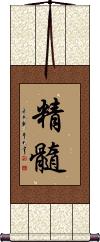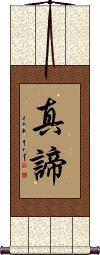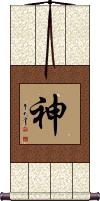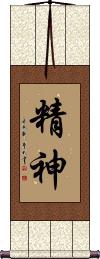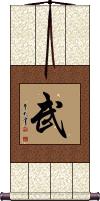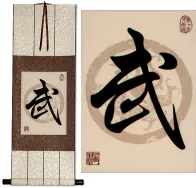Many custom options...
And formats...

Essence in Chinese / Japanese...
Buy an Essence calligraphy wall scroll here!
Personalize your custom “Essence” project by clicking the button next to your favorite “Essence” title below...
Essence
精髓 is the Chinese, Japanese Kanji, and old Korean Hanja for essence.
This can also be translated as marrow, pith, quintessence, kernel, spirit, etc.
This often refers to the nature or basis of whatever element, plant, animal, being, person, or thing you are talking about.
The original Chinese version (also Korean Hanja) and modern Japanese version of the second character differ a tiny bit:
![]() vs.
vs. ![]()
Both versions are so close that both Chinese and Japanese people will recognize this word. If you want the specifically-Japanese version, click on this link instead of the button above: Order Essence in Japanese
True Essence
Spirit / Spiritual Essence
神 is the simplest way to write spirit in Chinese, Japanese Kanji, and old Korean.
This single character alone will conjure up ideas of the spiritual world. 神 can also be translated as “vital awareness” as in the fact that one must know they exist to exist (I think, therefore, I am).
Other translations include:
God, deity, mysterious, divine essence, lively, spiritual being, divinity, supernatural, soul, mind, nerves, and energy. In some extended context, it can mean genius or unusual.
Japanese romanizations vary a lot when this character is combined into other words. However, shin is the original pronunciation taken from Chinese into Japanese. You'll also see it romanized as kami, gami, jin, and a few others, depending on context.
Spirit
精神 is the kind of spirit you have if you perform well in sports or competitions. It is the idea of having a good attitude and putting your all into something - so much so that others can see or feel your spirit. It is the essence of your being that can only be subjectively described because there are no words that can fully explain what “spirit” really is.
For your information:
My Japanese dictionary further tries to explain this word by comparing it to mind, soul, heart, or intention.
My Chinese dictionary compares these characters to meanings like vigor, vitality, drive, and mentality.
My Korean dictionary defines this as mind, spirit, and soul.
Warrior Essence / Warrior Spirit / Martial
武 is the essence or spirit of a warrior. 武 is part of the word “wu shu” which is sometimes translated as “martial arts” or “kung fu.”
In more modern speech and another context, this can mean military, martial, warlike, fierce, and perhaps violent but usually as a prefix for a longer word or phrase.
Life Energy / Spiritual Energy
Chi Energy: Essence of Life / Energy Flow
This 氣 energy flow is a fundamental concept of traditional Asian culture.
氣 is romanized as “Qi” or “Chi” in Chinese, “Gi” in Korean, and “Ki” in Japanese.
Chi is believed to be part of everything that exists, as in “life force” or “spiritual energy.” It is most often translated as “energy flow” or literally as “air” or “breath.” Some people will simply translate this as “spirit,” but you must consider the kind of spirit we're talking about. I think this is weighted more toward energy than spirit.
The character itself is a representation of steam (or breath) rising from rice. To clarify, the character for rice looks like this: ![]()
Steam was apparently seen as visual evidence of the release of “life energy” when this concept was first developed. The Qi / Chi / Ki character is still used in compound words to mean steam or vapor.
The etymology of this character is a bit complicated. It's suggested that the first form of this character from bronze script (about 2500 years ago) looked like these samples: 

However, it was easy to confuse this with the character for the number three. So the rice radical was added by 221 B.C. (the exact time of this change is debated). This first version with the rice radical looks like this: 
The idea of Qi / Chi / Ki is really a philosophical concept. It's often used to refer to the “flow” of metaphysical energy that sustains living beings. Yet there is much debate that has continued for thousands of years as to whether Qi / Chi / Ki is pure energy or consists partially or fully of matter.
You can also see the character for Qi / Chi / Ki in common compound words such as Tai Chi / Tai Qi, Aikido, Reiki, and Qi Gong / Chi Kung.
In the modern Japanese Kanji, the rice radical has been changed into two strokes that form an X.
![]() The original and traditional Chinese form is still understood in Japanese, but we can also offer that modern Kanji form in our custom calligraphy. If you want this Japanese Kanji, please click on the character to the right instead of the “Select and Customize” button above.
The original and traditional Chinese form is still understood in Japanese, but we can also offer that modern Kanji form in our custom calligraphy. If you want this Japanese Kanji, please click on the character to the right instead of the “Select and Customize” button above.
More language notes: This is pronounced like “chee” in Mandarin Chinese, and like “key” in Japanese.
This is also the same way to write this in Korean Hanja where it is Romanized as “gi” and pronounced like “gee” but with a real G-sound, not a J-sound.
Though Vietnamese no longer use Chinese characters in their daily language, this character is still widely known in Vietnam.
See Also: Energy | Life Force | Vitality | Life | Birth | Soul
This in-stock artwork might be what you are looking for, and ships right away...
Gallery Price: $90.00
Your Price: $49.88
Not the results for essence that you were looking for?
Below are some entries from our dictionary that may match your essence search...
| Characters If shown, 2nd row is Simp. Chinese |
Pronunciation Romanization |
Simple Dictionary Definition |
心 see styles |
xīn xin1 hsin haato / hato ハート |
More info & calligraphy: Heart / Mind / Spirit(1) (See 心・こころ・1) heart; mind; spirit; vitality; inner strength; (2) bottom of one's heart; core (of one's character); nature; (3) (usu. written as 芯) (See 芯・2) centre; center; core; heart; (4) (See 心臓・1) heart (organ); (5) {astron} (See 二十八宿) Chinese "Heart" constellation (one of the 28 mansions); (6) (archaism) (child. language) friend; (given name) Haato hṛd, hṛdaya 汗栗太 (or 汗栗馱); 紀哩馱 the heart, mind, soul; citta 質多 the heart as the seat of thought or intelligence. In both senses the heart is likened to a lotus. There are various definitions, of which the following are six instances: (1) 肉團心 hṛd, the physical heart of sentient or nonsentient living beings, e. g. men, trees, etc. (2) 集起心 citta, the ālayavijñāna, or totality of mind, and the source of all mental activity. (3) 思量心 manas, the thinking and calculating mind; (4) 緣慮心; 了別心; 慮知心; citta; the discriminating mind; (5) 堅實心 the bhūtatathatā mind, or the permanent mind; (6) 積聚精要心 the mind essence of the sutras. |
理 see styles |
lǐ li3 li wataru わたる |
More info & calligraphy: Science(1) reason; principle; logic; (2) {Buddh} (See 事・じ) general principle (as opposed to individual concrete phenomenon); (3) the underlying principles of the cosmos (in neo-Confucianism); (given name) Wataru siddhānta; hetu. Ruling principle, fundamental law, intrinsicality, universal basis, essential element; nidāna, reason; pramāṇa, to arrange, regulate, rule, rectify. |
眼 see styles |
yǎn yan3 yen manako まなこ |
More info & calligraphy: Eyeballs / Eyes(1) eye; eyeball; (2) (archaism) pupil and (dark) iris of the eye; (3) (archaism) insight; perceptivity; power of observation; (4) (archaism) look; field of vision; (5) (archaism) core; center; centre; essence; (surname) Mesaki cakṣuh, the eye. |
空 see styles |
kòng kong4 k`ung kung kuu / ku くう |
More info & calligraphy: Sky / Ether / Void / Emptiness / Unreality(1) empty air; sky; (2) {Buddh} shunyata (the lack of an immutable intrinsic nature within any phenomenon); emptiness; (3) (abbreviation) (See 空軍) air force; (noun or adjectival noun) (4) fruitlessness; meaninglessness; (noun or adjectival noun) (5) (See 五大・1) void (one of the five elements); (can be adjective with の) (6) {math} empty (e.g. set); (female given name) Ron śūnya, empty, void, hollow, vacant, nonexistent. śūnyatā, 舜若多, vacuity, voidness, emptiness, non-existence, immateriality, perhaps spirituality, unreality, the false or illusory nature of all existence, the seeming 假 being unreal. The doctrine that all phenomena and the ego have no reality, but are composed of a certain number of skandhas or elements, which disintegrate. The void, the sky, space. The universal, the absolute, complete abstraction without relativity. There are classifications into 2, 3, 4, 6, 7, 11, 13, 16, and 18 categories. The doctrine is that all things are compounds, or unstable organisms, possessing no self-essence, i.e. are dependent, or caused, come into existence only to perish. The underlying reality, the principle of eternal relativity, or non-infinity, i.e. śūnya, permeates all phenomena making possible their evolution. From this doctrine the Yogācārya school developed the idea of the permanent reality, which is Essence of Mind, the unknowable noumenon behind all phenomena, the entity void of ideas and phenomena, neither matter nor mind, but the root of both. |
生命 see styles |
shēng mìng sheng1 ming4 sheng ming seimei / seme せいめい |
More info & calligraphy: Life Force(1) life; existence; (n,n-suf) (2) (See 役者生命) (one's) working life; career; (3) (occ. read いのち) life force; lifeblood; soul; essence |
真諦 真谛 see styles |
zhēn dì zhen1 di4 chen ti shindai しんだい |
More info & calligraphy: True Essence(1) {Buddh} (esp. しんたい) (See 俗諦) ultimate truth; (2) (esp. しんてい) essence; (person) Paramartha (499-569 CE) |
精神 see styles |
jīng shen jing1 shen5 ching shen seishin / seshin せいしん |
More info & calligraphy: Spirit(1) mind; spirit; soul; heart; ethos; (2) attitude; mentality; will; intention; (3) spirit (of a matter); essence; fundamental significance; (given name) Seishin Vitality; also the pure and spiritual, the subtle, or recondite. |
精華 精华 see styles |
jīng huá jing1 hua2 ching hua seika / seka せいか |
More info & calligraphy: Seika / Quintessenceessence; quintessence; flower; glory; (f,p) Seika |
精髓 see styles |
jīng suǐ jing1 sui3 ching sui |
More info & calligraphy: Essence |
性 see styles |
xìng xing4 hsing shou / sho しょう |
nature; character; property; quality; attribute; sexuality; sex; gender; suffix forming adjective from verb; suffix forming noun from adjective, corresponding to -ness or -ity; essence; CL:個|个[ge4] (archaism) disposition; nature; character; (surname) Shou svabhāva, prakṛti, pradhāna. The nature intp. as embodied, causative, unchanging; also as independent or self-dependent; fundamental nature behind the manifestation or expression. Also, the Buddha-nature immanent in all beings, the Buddha heart or mind. |
矣 see styles |
yǐ yi3 i i |
classical final particle, similar to modern 了[le5] A particle of finality, pronounced yi, used in 矣栗駄 hṛd, the heart; the essence of a thing. |
粋 see styles |
cuì cui4 ts`ui tsui sui すい |
Japanese variant of 粹 (1) essence; the best; cream; (noun or adjectival noun) (2) (See 粋・いき・1) chic; smart; stylish; tasteful; refined; sophisticated; (noun or adjectival noun) (3) considerate; understanding; thoughtful; tactful; (noun or adjectival noun) (4) familiar with worldly pleasures (esp. sexual relations, geisha districts and red-light districts); (female given name) Sui |
粹 see styles |
cuì cui4 ts`ui tsui |
pure; unmixed; essence |
精 see styles |
jīng jing1 ching makoto まこと |
essence; extract; vitality; energy; semen; sperm; mythical goblin spirit; highly perfected; elite; the pick of something; proficient (refined ability); extremely (fine); selected rice (archaic) (1) spirit; sprite; nymph; (2) energy; vigor (vigour); strength; (3) fine details; (4) (See 精液) semen; (given name) Makoto Cleaned rice, freed from the husk, pure; essential, essence, germinating principle, spirit; fine, best, finest. |
素 see styles |
sù su4 su motoi もとい |
raw silk; white; plain, unadorned; vegetarian (food); essence; nature; element; constituent; usually; always; ever (1) white silk; (2) {math} (See 互いに素・1) prime; (3) {chem} principle; (given name) Motoi Original colour or state; plain, white; heretofore, usual; translit. su.; To keep to vegetarian diet; vegetarian. |
腦 脑 see styles |
nǎo nao3 nao nō |
brain; mind; head; essence brain |
一如 see styles |
yī rú yi1 ru2 i ju ichinyo いちにょ |
to be just like oneness; (personal name) Kazuyuki The one ru, i.e. the bhūtatathatā, or absolute, as the norm and essence of life. The 眞如 true suchness, or true character, or reality; the 法性 nature of things or beings. The whole of things as they are, or seem; a cosmos; a species; things of the same order. Name of a celebrated monk, Yiru. V. 一眞; 一實. |
七曜 see styles |
qī yào qi1 yao4 ch`i yao chi yao shichiyou / shichiyo しちよう |
the seven planets of premodern astronomy (the Sun, the Moon, Mercury, Venus, Mars, Jupiter, and Saturn) (1) {astron} the seven luminaries (sun, moon, Mercury, Venus, Mars, Jupiter and Saturn); (2) the seven days of the week The seven brilliant ones — the sun and moon, together with the five planets which are connected with fire, water, wood, metal, and earth. Their essence shines in the sky, but their spirits are over men as judges of their good and evil, and as rulers over good and evil fortune. The following list shows their names in Chinese and Sanskrit: Sun 日, 太陽; aditya 阿彌底耶 Moon月, 太陰; soma 蘇摩 Mars火星, 勢惑勞; aṅgāraka 盎哦囉迦 Mercury水星, 辰星; budha 部陀 Jupiter木星, 歳星; bṛhaspati 勿哩訶娑跛底 Venus金星, 太白; śukra 戌羯羅 Saturn土星, 鎭星; śanaiścara 賖乃以室折羅. |
三大 see styles |
sān dà san1 da4 san ta miou / mio みおう |
(prefix) (See 三大疾病) the big three ...; (surname) Miou The three great characteristics of the 眞如 in the 起信論 Awakening of Faith: (1) 體大 The greatness of the bhūtatathatā in its essence or substance; it is 衆生心之體性 the embodied nature of the mind of all the living, universal, immortal, immutable, eternal; (2) 相大 the greatness of its attributes or manifestations, perfect in wisdom and mercy, and every achievement; (3) 用大 the greatness of its functions and operations within and without, perfectly transforming all the living to good works and good karma now and hereafter. There are other groups, e.g. 體, 宗, and 用. |
三身 see styles |
sān shēn san1 shen1 san shen sanmi さんみ |
{Buddh} trikaya (three bodies of the Buddha); (surname) Sanmi trikāya. 三寶身 The threefold body or nature of a Buddha, i.e. the 法, 報, and 化身, or dharmakāya, sambhogakāya, and nirmāṇakāya. The three are defined as 自性, 受用, and 變化, the Buddha-body per se, or in its essential nature; his body of bliss, which he "receives" for his own "use" and enjoyment; and his body of transformation, by which he can appear in any form; i.e. spiritual, or essential; glorified; revealed. While the doctrine of the trikāya is a Mahāyāna concept, it partly results from the Hīnayāna idealization of the earthly Buddha with his thirty-two signs, eighty physical marks, clairvoyance, clairaudience, holiness, purity, wisdom, pity, etc. Mahāyāna, however, proceeded to conceive of Buddha as the Universal, the All, with infinity of forms, yet above all our concepts of unity or diversity. To every Buddha Mahāyāna attributed a three-fold body: that of essential Buddha; that of joy or enjoyment of the fruits of his past saving labours; that of power to transform himself at will to any shape for omnipresent salvation of those who need him. The trinity finds different methods of expression, e.g. Vairocana is entitled 法身, the embodiment of the Law, shining everywhere, enlightening all; Locana is 報身; c.f. 三賓, the embodiment of purity and bliss; Śākyamuni is 化身 or Buddha revealed. In the esoteric sect they are 法 Vairocana, 報 Amitābha, and 化 Śākyamuni. The 三賓 are also 法 dharma, 報 saṅgha, 化 buddha. Nevertheless, the three are considered as a trinity, the three being essentially one, each in the other. (1) 法身 Dharmakāya in its earliest conception was that of the body of the dharma, or truth, as preached by Śākyamuni; later it became his mind or soul in contrast with his material body. In Mādhyamika, the dharmakāya was the only reality, i.e. the void, or the immateria1, the ground of all phenomena; in other words, the 眞如 the tathāgatagarbha, the bhūtatathatā. According to the Huayan (Kegon) School it is the 理or noumenon, while the other two are氣or phenomenal aspects. "For the Vijñānavāda... the body of the law as highest reality is the void intelligence, whose infection (saṃkleҫa) results in the process of birth and death, whilst its purification brings about Nirvāṇa, or its restoration to its primitive transparence" (Keith). The "body of the law is the true reality of everything". Nevertheless, in Mahāyāna every Buddha has his own 法身; e.g. in the dharmakāya aspect we have the designation Amitābha, who in his saṃbhogakāya aspect is styled Amitāyus. (2) 報身Sambhogakāya, a Buddha's reward body, or body of enjoyment of the merits he attained as a bodhisattva; in other words, a Buddha in glory in his heaven. This is the form of Buddha as an object of worship. It is defined in two aspects, (a) 自受用身 for his own bliss, and (b) 他受用身 for the sake of others, revealing himself in his glory to bodhisattvas, enlightening and inspiring them. By wisdom a Buddha's dharmakāya is attained, by bodhisattva-merits his saṃbhogakāya. Not only has every Buddha all the three bodies or aspects, but as all men are of the same essence, or nature, as Buddhas, they are therefore potential Buddhas and are in and of the trikāya. Moreover, trikāya is not divided, for a Buddha in his 化身 is still one with his 法身 and 報身, all three bodies being co-existent. (3) 化身; 應身; 應化身 nirmāṇakāya, a Buddha's transformation, or miraculous body, in which he appears at will and in any form outside his heaven, e.g. as Śākyamuni among men. |
主眼 see styles |
shugan しゅがん |
(1) main purpose; chief aim; focus; (2) main point; gist; essence |
二土 see styles |
èr tǔ er4 tu3 erh t`u erh tu nido |
There are three groups: 性土 and 相土 : the former is the ubiquitous, unadulterated or innocent 法性之理 dharma-name, or essence of things; the latter is the form-nature, or formal existence of the dharma, pure or impure according to the mind and action of the living. The 淨土 and 穢土 are Pure-land or Paradise; and impure land, e.g. the present world. In the Pure-land there are also 報土 , the land in which a Buddha himself dwells and 化土 in which all beings are transformed. There are other definitions, e. g. the former is Buddha's Paradise, the latter the world in which he dwells and which he is transforming, e. g. this Sahā-world. |
二如 see styles |
èr rú er4 ru2 erh ju ninyo |
There are various definitions of the two aspects of the 眞如 bhūtatathatā. (1) (a) 不變眞如 The changeless essence or substance, e.g. the sea; (b) 隨緣眞如 its conditioned or ever-changing forms, as in the phenomenal world, e.g. the waves. (2) (a) 離言眞如 The inexpressible absolute, only mentally conceivable; (6) 依言眞如 aspects of it expressible in words, its ideal reflex. (3) (a) 空眞如 The absolute as the void, e.g. as space, the sky, a clear mirror; (b) 不空眞如 the absolute in manifestation, or phenomenal, e. g. images in the mirror: the womb of the universe in which are all potentialities. (4) (a) 在纏眞如The Buddha-nature in bonds, i.e. all beings in suffering; (b) 出纏真如the Buddha-nature set free by the manifestation of the Buddha and bodhisattvas. (5) (a) 有垢眞如The Buddha-nature defiled, as in unenlightened man, etc., e.g. the water-lily with its roots in the mud; (b) 無垢眞如 the pure Buddha-nature, purifed or bright as the full moon. (6) 安立 and 非安立眞如 similar to the first definition given above. |
修堅 修坚 see styles |
xiū jiān xiu1 jian1 hsiu chien shuken |
Firmness in observing or maintaining; established conviction, e.g. of the 別教 bodhisattva that all phenomena in essence are identical. |
元神 see styles |
yuán shén yuan2 shen2 yüan shen motogami もとがみ |
primordial spirit; fundamental essence of life (surname) Motogami |
內核 内核 see styles |
nèi hé nei4 he2 nei ho |
core (of a fruit); (fig.) the essence (of a concept or doctrine etc); (geology) inner core; (computing) kernel See: 内核 |
共體 共体 see styles |
gòng tǐ gong4 ti3 kung t`i kung ti gūtai |
shares the same essence |
國粹 国粹 see styles |
guó cuì guo2 cui4 kuo ts`ui kuo tsui |
national essence; quintessence of national culture |
圓覺 圆觉 see styles |
yuán jué yuan2 jue2 yüan chüeh engaku |
Complete enlightenment potentially present in each being, for all have 本覺 primal awareness, or 眞心 the true heart (e. g. conscience), which has always remained pure and shining; considered as essence it is the 一心 one mind, considered causally it is the Tathāgata-garbha, considered it is|| perfect enlightenment, cf. 圓覺經. |
地体 see styles |
jitai じたい |
(1) (archaism) essence; true nature; substance; reality; (adverb) (2) (archaism) originally; naturally; by nature; from the start |
Click here for more essence results from our dictionary
The following table may be helpful for those studying Chinese or Japanese...
| Title | Characters | Romaji (Romanized Japanese) | Various forms of Romanized Chinese | |
| Essence | 精髓 / 精髄 精髓 | sei zui / seizui | jīng suǐ / jing1 sui3 / jing sui / jingsui | ching sui / chingsui |
| True Essence | 真諦 真谛 | shintai / shintei | zhēn dì / zhen1 di4 / zhen di / zhendi | chen ti / chenti |
| Spirit Spiritual Essence | 神 | shin / kami | shén / shen2 / shen | |
| Spirit | 精神 | sei shin / seishin | jīng shén jing1 shen2 jing shen jingshen | ching shen chingshen |
| Warrior Essence Warrior Spirit Martial | 武 | bu | wǔ / wu3 / wu | |
| Life Energy Spiritual Energy | 氣 气 / 気 | ki | qì / qi4 / qi | ch`i / chi |
| In some entries above you will see that characters have different versions above and below a line. In these cases, the characters above the line are Traditional Chinese, while the ones below are Simplified Chinese. | ||||
Successful Chinese Character and Japanese Kanji calligraphy searches within the last few hours...
